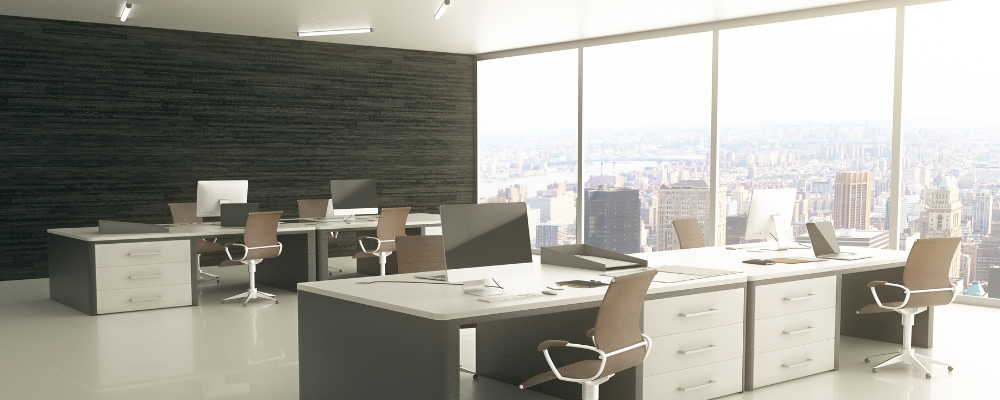Creating a perfect lighting plan strategy for your workspace that perfectly illuminates it is essential to your health and productivity. The lighting you select for your workspace can affect everything from the well-being of your team to how much you accomplish.
Health concerns such as eye strain, headaches, and low mood in the workplace can all be traced back to poor lighting. If you want to facilitate a productive workspace for yourself and your team, ensure you’re carefully crafting the right lighting plan.
In this post, we cover the following lighting plan topics:
- What types of lighting exist for workspaces?
- What kind of lighting do you need in your workspace?
- How should you install or place various lighting in your workspaces?
Creating a Lighting Plan Strategy For Your Workspace
Creating the perfect lighting plan for your workspace takes a strategic approach. With different lighting sources to consider, you must take the appropriate amount of time to select the right sources for your space.
Taking into account current lighting sources, such as overhead lighting and natural light, will help you determine complementary lighting. The first step then is to ask yourself:
What types of lighting exist and which one do you need in your workspace?
- Overhead lighting often comes standard in both commercial and personal workspaces. If your workspace comes equipped with overhead lighting, you may consider changing the lighting technologies.
Overhead lighting is often outfitted with fluorescent bulbs. While fluorescent lighting is typical, these bulbs and tubes can expose you to harmful UV/IV rays and may cause increased eye strain. If you need overhead lighting in your workspace, consider LED tube lights and bulbs instead of fluorescent alternatives. LEDs are 50% more efficient, brighter, less harmful, and last much longer than fluorescent lighting options.
2. Accent lighting is essential for highlighting architectural features and artwork displays. This type of lighting works well in reception and lobby areas of commercial workspaces.
While accent lighting doesn’t boast the same health benefits as adequate overhead lighting, task lighting, and natural light, it can greatly affect the overall well-being of workers. Accent lighting complements overhead lighting and adds to the overall brightness and interest of the space. Not only that, but accent lighting helps improve the overall ambiance of a workspace and helps improve mood.
3. Task lighting is a critical component of your personal workspace lighting plan. In combination with overhead lighting, task lighting provides customizable brightness levels, boosts productivity, and keeps energy costs down.
LED task lighting is an ergonomic tool that offers complete control over the amount of light needed to complete certain tasks. Many of us spend hours reading and working at our desks, and adding a task lamp helps to keep us focused on our various projects.

Lighting Placement for the Optimal Workspace
One benefit of creating a lighting plan strategy before selecting or changing your workspace lighting is you can carefully consider your lighting needs. You may find that you need a combination of all three lighting options, or you may decide all you need is to add an attractive task lamp to enhance your workspace lighting plan.
Whatever you decide, the next step in creating the perfect lighting plan for your workspace is determining the best placement for your lighting options. Let’s walk through the different spaces you may have in your workspace and the lighting choices you should consider adding.
Reception area
If you have a reception or lobby area of your workspace that needs to be outfitted with appropriate lighting, consider both overhead lighting and accent lighting. Hanging pendants above a reception desk or waiting area provides the brightness the space needs with an added design element. Don’t be afraid to get creative with your overhead lighting!
Accent lighting in the reception area can highlight your company name or interesting interior decor, such as artwork. Accent lighting in the reception area enhances the ambiance and sets the tone for your guests.
Open-plan Workspaces
In recent years, many companies have shifted to open floorplans where workspaces are clustered together in an open space, sans cubicles. This type of workspace requires plenty of natural light and overhead lighting.
Take into consideration how much natural light enters the workspace and add as much LED overhead lighting as you need to make the space bright and welcoming. Open workspaces can quickly feel dingy and unwelcoming with poor overhead lighting. Boost productivity and well-being with the right lighting temperature and voltage.

Individual desks
Whether individual desks are positioned in an open workspace or separated by traditional cubicles, it’s important to add task lighting. As outlined above, task lighting is essential for ergonomics, productivity, and eye health. Ensure your task lamp is adjustable and suits your working style.
Office space
If you work in a separate office, consider a combination of overhead, accent, and task lighting. Overhead lighting is essential if you do not have little or no natural light to work with. Accent lighting in an office space can enhance your workspace to boost creativity and mood. Plus, accent lighting can be a wonderful way to create separate spaces within your office for different tasks such as meetings with clients or taking a mid-day break.
As with individual and open floorplan workspaces, task lighting is essential even if you leverage overhead and accent lighting. Task lamps come in various design styles, and it can be easy to find the perfect lamp to enhance your office workspace.
Creating a lighting plan that perfectly illuminates your workspace is simple if you take the time to consider your options and unique workspace requirements. Choosing the right lighting sources for your workspace can enhance productivity, mood, and overall well-being.
If you need help creating a strategy that works with your overall design, contact us today. We can help make your workspace a beautiful expression of design and purpose.




